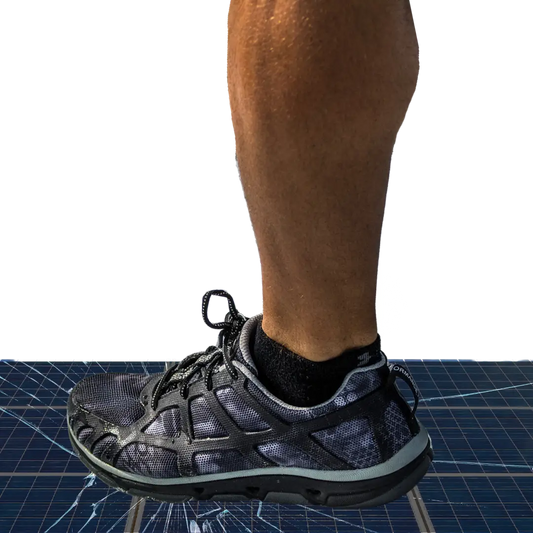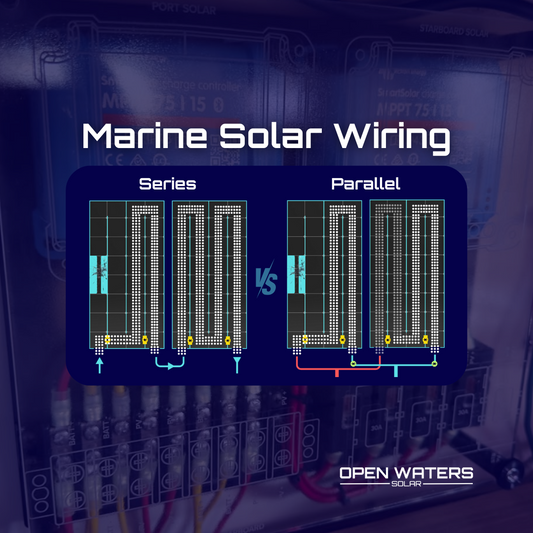Marine Solar Panels: Cracks, How They Happen, and How to Avoid Them

Share
There are two main types of solar panels you’d put on a boat: flexible (semi-flex) and rigid. Flexible panels are lightweight, thin, and can bend slightly to fit curved surfaces. You’ll see them glued straight onto decks, canvas biminis, or other parts of a boat. Some even come with a peel-and-stick backing. Then there are rigid panels—the same kind you’d see on houses, but sometimes built differently for mobile environments. They’re more durable, don’t bend, and often need a frame or mounting structure.
Rigid panels last longer and handle rough conditions better. They can even survive a hailstorm, but you still don’t want to walk on them—glass cracks under weight. They also take up more space and require mounting structures, which can be an issue depending on your boat setup. Flexible panels are easier to install and don’t require frames, but they come with a major downside: they’re fragile. And when they crack, that’s where the problems start.
Disclaimer: We started as an electric catamaran manufacturer. We encountered these problems with solar, we solved them. Now we have the most durable solar panels available. But these problems still exist for other solar panels (not ours). We aren't being dramatic either, solar is extremely fragile.
How Do Solar Panels Crack?
Cracking in solar panels—especially flexible ones—happens way easier than most people think. Some panels even come with cracks right out of the box. A tiny amount of pressure, a strong gust of wind moving the canvas, or even just regular wear and tear can create cracks in the cells. Here’s how it happens:
1. Installation Issues
- Overbending – Flexible doesn’t mean indestructible. If you bend a panel too much during installation, you’ll stress the solar cells inside.
- Impact - Touch it wrong during installation. Test it out, pinch your solar panel with your ear next to it. You can hear the cell cracking. That's how easy it is.
3. Impact
- Something Dropped on It – A rope, a tool, a small winch handle—doesn’t take much. Even a knot in a rope smacking down can be enough to crack a flexible panel.
- Walking on Them – Stepping on your solar panel is a bad idea. That pressure creates a dead zone. The cell expands within the panel and cracks.
- Vibrations from the Boat – If the panel is installed in a way that allows small, constant vibrations (say, from engine rumble or rough seas), those movements add up and can cause fractures over time.
4. Weather
- Hailstorms – While rigid panels can survive most hail, flexible panels are far more vulnerable. The impact of even small hailstones can leave cracks in the solar cells.
- Extreme Heat and Cold – The constant expansion and contraction from temperature swings can create stress points in the panel, leading to small fractures over time.
- Wins - If you stick a flexible panel onto a bimini or another fabric surface, wind can cause constant flexing. Over time, that movement leads to cracks.
5. Manufacturing Defects
- Not all panels are created equal. Some arrive from the factory with tiny micro-cracks that aren’t visible but will grow over time. You’d never know unless you used an EL (Electroluminescence) camera, which is a tool used to detect invisible cracks in solar cells.
Why Are Cracks a Big Deal?
Cracks might not seem like much at first. Sometimes, a panel will still work even with damage. But the issue isn’t just about whether the panel “turns on” or not—it’s about efficiency loss and long-term performance.
1. Micro-Cracks Lead to Bigger Cracks
A tiny crack in a solar cell doesn’t stay tiny. As the panel flexes, vibrates, or takes more impacts, that crack spreads. Eventually, the cell breaks enough that it either stops working or significantly reduces power output.
2. Cracks Cause a Bottleneck
Solar panels work by generating current, but if a cell is cracked, it creates resistance. That resistance slows down the flow of electricity, limiting how much power the entire panel, and even array can produce.
3. Hot Spots Can Form
When a cell is cracked and struggling to push current through, the affected area heats up. This is called a hot spot, and over time, it can burn through the panel’s protective layers, damage surrounding materials, or in rare cases, even start a fire.
4. Bypass Diodes Help—But Only to a Point
Most solar panels have bypass diodes, which create a shortcut in the circuit so some current can be maintained. But there’s a catch: while a bypass diode keeps the power flowing, it doesn’t fix the damage. That section of the panel is still dead weight. It will always be dead weight. Maybe there are 2 bypass diodes. If one cell is cracked, that means likely 1/3 of the panel will be bypassed. Maintaining current, but a loss of voltage and power.
How to Prevent Solar Panel Cracks
Solar panels aren’t cheap, and if professionally installed, that installation was more than the panels.
1. Install Them Correctly
- If you’re using flexible panels, don’t overbend them. Keep them as flat as possible, and avoid gluing them down with zero room for expansion.
- If mounting on canvas, make sure it’s tight enough to reduce movement but not so tight that it causes stress fractures.
- For rigid panels, use vibration-dampening mounts if your boat experiences a lot of movement.
2. Protect Against Impact
- Don’t walk on them
- Keep panels covered during storms if hail is expected.
- Secure loose gear so nothing drops onto the panels unexpectedly.
3. Choose High-Quality Panels
- Some solar panels are more durable. But honestly there is not too much of a difference between name brand cheap, and name brand expensive. We have tested panels from all price points with all sorts of durability claims.
- Avoid cheap, off-brand panels.
What to Do If Your Panel is Cracked?
If you suspect a crack, here’s what to do:
- Check Power Output – Use a multimeter to see if the panel’s voltage and current are significantly lower than expected.
- Determine the Severity – If the crack is minor, the panel might still work at reduced efficiency. If it’s bad, it could be bottlenecking the entire system.
- Isolate the Panel – If it’s affecting the whole array, consider disconnecting it. A bad panel can drag down the performance of the others.
Final Thoughts
Solar panels on boats take a beating. Between the constant movement, weather exposure, and occasional impacts, it’s no surprise they crack. Flexible panels, while convenient, are especially vulnerable. The best thing you can do is install them properly, handle them with care, and regularly check for damage.
At Open Water Solar, we designed our panels to be the most durable flexible marine solar panels out there because we saw firsthand how fragile the options are.



